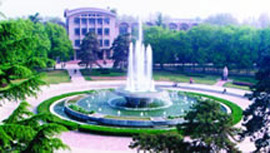West Meets East
By: Elizabeth Anderson
The following is the first in a series of reports that Elizabeth Anderson, a CoAg alumnaae who is teaching in China, will be sending chronicling her experiences with Chinese agriculture.
Greetings to you from my students at Northwest Sci-Tech University of Agriculture and Forestry (here on Northwest A&F University), one of the top three agricultural universities in all of China. This university is home to the world's first cloned goat, Yang Yang, and three succeeding generations attracting one million visitors.

The fountain at Northwest Sci-Tech
University in Shaanxi Province, China.
My 85 students are sophomores majoring in agricultural biotechnology and bioengineering, some of the very brightest at this university. When I told them I was going to write about them for an Auburn University publication, they were very happy and interested and hope to establish contact with some Auburn students and share ideas. If interested, you can get my email address from the Auburn fisheries department office.
I am a 1991 Auburn graduate with a master's of aquaculture from the Department of Fisheries and Allied Aquacultures. I do not teach aquaculture here, but biochemistry.
Northwest A&F University is located in Shaanxi Province in what is called the northwest part of China. If you look on a map it is in the northwest part of the eastern half of the country. The western half has deserts and is not as populated.
The winter climate here is a little colder than in southern Alabama, but the snowfall is very light, not unlike my hometown near Chicago.
Shaanxi Province has much farmland, mostly in wheat and corn cultivation. To the north are many apple orchards. To the south I can see the lovely Qin Ling mountain range out of my apartment window.
The university is very picturesque: tree-lined pathways, gardens and a big fountain in the center. The north part of the campus where I live is on a hill overlooking a small town, Yangling. But within one hour's distance is a modern city called Xi'an. In recent years it has become an especially popular tourist destination because of the discovery beneath a farmer's field of some 10,000 lifesize, terra cotta soldiers "guarding" the tomb of an ancient emperor.
Auburn's fish geneticist Dr. John Liu was instrumental in setting up a sister relationship between the two universities. He is an adjunct professor here. Other Auburn faculty such as Dr. Richard Guthrie and Dr. James Bannon, also keep close ties between the two universities.
My students had to study very hard to get into a university because there was so much competition for the available spaces. In the last two years of high school—what is called senior middle school—they had little time for sports or extracurricular activities because of long hours in class, six days a week, and many hours of study.
Now that they are in university my students are taking six courses this term including plant physiology, physics, microbiology, physical chemistry and English. They have to reach a certain level of English proficiency in order to graduate. Of course the job market is also very competitive.
Many of my students are very gifted artists, as I have received some lovely pen-and-ink drawings. Many like to use fountain pens. Their work is very neat because they had to learn in primary school to draw complex Chinese characters in the correct stroke order and style.
By the time they get to the university, they have already had five years of English and an introduction to Western novels and culture from their teachers. Some like Chinese pop music, some Western pop. Others have a variety of musical and literary interests.
The young men and women live separately. Most live in large dormitory rooms with five other roommates. They do their own laundry and eat well in cafeterias. You've probably heard Chinese food is very nutritious and delicious. Some have their own computers and watch movies on them or chat online. For recreation the young men go to computer centers to play video games, or to the large outdoor recreation center to play ping pong or basketball.
Northwest A&F University is supported and administered at both national and provincial levels as one of the country's "key" universities. In 1999, seven universities in Yangling merged into this one university, which now has 20,000 students. It has 59 disciplines in 16 colleges. It offers 78 master degree programs and 58 doctoral degree programs. Its overall emphasis is to provide training in agriculture, forestry and water resources.
The university's strongest disciplines include dryland farming, water-saving irrigation, wheat breeding, comprehensive management of soil and water erosion and biotechnology. Many achievements have been recognized internationally.
The university has established cooperative arrangements with more than 40 universities and research institutes around the world.
Mr. Qiao Wenjun, of the Office of International Cooperation and Exchange, extends a warm welcome to any students or faculty who would like to visit.
